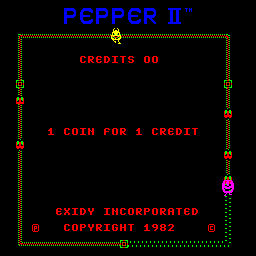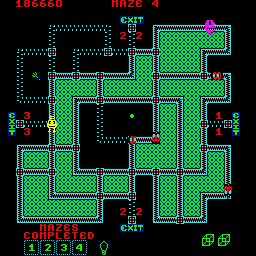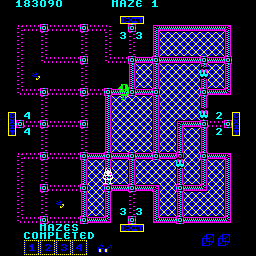
Arcade Mermaid is our classic arcade weirdness and obscurity column! Once a month we aim to bring you an interesting and odd arcade game to wonder at.
Released in 1982, a couple of years after a little game called Pac-Man, Pepper II is a maze game set in a four-screen world. You’re a blobby angel thing called Pepper, obeying an edict from the Powers Above: zip up four screens’ worth of boxes. The box borders are made of un-zipped zippers, and by zooming around each one it’s zipped up and captured, filled with a pattern.

Opposing your efforts are a bunch of roving eyes and a weird pink creature callled “the Whippersnapper.” It was the golden age of arcades, and realistic scenarios were on the outs for a time.
Its box-surrounding play looks similar to Amidar at first, but it’s really quite a different game. Amidar‘s enemies move according to a set and inviolate plan, but the eyes of Pepper II rove mostly randomly, with a slight bias towards chasing you. Amidar only lets you attack your enemies once per board, after you’ve surrounded all four corners, but Pepper gets this power after capturing just one of the corners, or the box in the center, up to five times per maze. This means that you’re invincible a lot of the time! Play carefully and you’re almost always invincible, which is important because you’re really vulnerable when you’re not. There are up to three more enemies after you at a time than in Pac-Man, and their unpredictable meandering means you often get caught right as you’re finishing a box.
Pepper’s world isn’t a single screen, but consists of four interconnected mazes. The arcade manual calls them cubes, and when you clear one you get a little cube icon in the bottom-right corner of the screen, but it isn’t a cube really; there’s only four sides. The game world is more like a horizontal strip. When you go off-screen to the left or right, you enter the next screen in the strip, but if you go up or down you skip ahead/behind one screen. From Screen 1, left goes to 4, right goes to 2, but both up and down go to 3. Enemies don’t have an off-screen existence beyond a few seconds after you change mazes, but your progress on other screens is remembered, so you can solve each maze a bit at a time if you choose.

The best thing Pepper II has going for it is its speed. It is incredibly fast! It makes Pac-Man feel creaky by comparison! Surrounding an energizer box gets you only four seconds of invincibility, but it’s long enough to surround multiple other boxes.
Pepper likes to overshoot intersections, and even with attention you’ll still probably miss them sometimes. When you enter a new maze, enemies enter from the four sides randomly after only a second, and at the game’s speeds this makes them very dangerous at that time. You could start capturing a box, and by the time you’re all the way around it a roving pair of eyes have both entered and moved over into your path. The eyes are not focused pursuers, but their large number and randomness make them plenty deadly enough.

The Whippersnapper is a little special. When you activate an energizer you can destroy the eyes for points, but will just pass through the Whippersnapper. The Whippersnapper exists to prevent you from zipping up tracks randomly. It undoes your work as it moves through the maze! Once you’ve completely captured a box it’s safe and cannot be unzipped, but until then it’s easy for it to mess up your work. It also moves much faster than the eyes.
There’s a couple more nuances to play. If you go back over your own trail you’ll unzip it. There are bonus items you can surround for ever-increasing bonuses as the game continues. The energizer in the center of the board flips between a stronger version that also kills all the enemies on the screen. These play quirks don’t really amount to all that much. Pepper II is a game about careening at full tilt around a board, clearing it piece by piece, and frantically racing between energizers to keep your invincibility going, and the other details tend to get lost in the rush.

Extra lives are awarded at 40,000 and 80,000 points. A good early score is around 50,000. I can regularly break 200,000, clearing two cubes, but the difficulty goes up rapidly from there. Both as you continue in each board and as the game goes on the enemies speed up a lot, and starting with the second cube the unzipped trails turn invisible for short periods.
About Exidy
Exidy was founded by in the very early days of arcade gaming. Some of their better known games include Star Fire, Mouse Trap, and Venture. They were never known for their graphics, although some of their products were among the earliest arcade games to use digitized sound. Many of Exidy’s games made up for their lack of visual flair with strong gameplay fundamentals. Venture, particularly, is a minor classic. Exidy was known to court controversy at times, with games like Death Race, in which the player runs down pedestrians, and the excessively-gory Chiller, where the player uses a light gun to dismember helpless victims in a torture room. Chiller received an unlicensed port to the NES by AGC (“American Game Cartridges”).
Coleco ported Mouse Trap, Pepper II, and Venture to the Colecovision console, where they were met by an appreciative audience. Their port of Pepper II is especially good. It’s very much like the arcade game, just a little slower.
Exidy games from the time of Pepper II tend to have a visual look akin to DOS games played through a CGA card. Pepper II is like this, but it certainly can’t be called slow. It takes sharp reflexes just to get around its mazes.

Would love this on the Evercade
Yes! It seems that there was a grant of rights, or at least an intent of one, to the public for free for non-commercial use. For Evercade, they’d still have to make arrangements, probably.